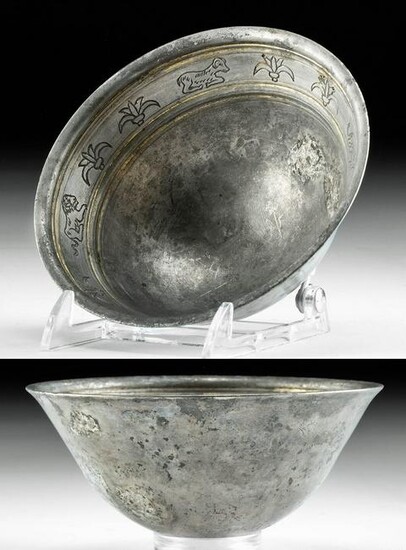Greek Hellenistic Gilt Silver Mastoid w/ Zoomorphs
Greece, Hellenistic Period, ca. late 4th to 3rd century BCE. A wonderful cup cast from 87.2% silver with traces of gilt, in the form of a mastos or mastoid drinking vessel. The vessel is conical in form, shaped intentionally like a breast, with a rounded base and walls that swell outward to a rim with a deep interior basin. The exterior is unadorned, but the interior is decorated with an incised band of zoomorphic and foliate patterns. The motif alternates between leafy palm fronds and a male lion, female lion, and two recumbent rams. Traces of the gold gilt are nicely preserved within the recessed areas of the basin. During the Hellenistic period, wealthy Greeks used silver as a marker of wealth more commonly than they had in the past. During the fifth century, a new silver source was discovered in the Laurium Hills in Attica, which was mined extensively soon thereafter. The profits from the mines enriched several Athenian families and created a greater pool of silver with which artisans could produce fine goods like this cup. Size: 5.25" Diameter x 2.375" H (13.3 cm x 6 cm); quality of silver: 87.2%; total weight: 170 grams
The mastos form seems to be deliberately breast-shaped, based on archaeological findings suggesting ritual functions for these cups. Mastoid cups and ceramic votive representations of breasts have been found at sanctuaries to Diana and Hercules - two figures in classical religion associated with birth, nursing, and rearing children. Fascinatingly, some of these even have dedications made by wet nurses. Some scholars theorize that the drinking of breast milk from a vessel like this one by an elderly or deathly ill adult symbolized rebirth in the afterlife.
Provenance: ex-private Maryland, USA collection, acquired in the 1960s
All items legal to buy/sell under U.S. Statute covering cultural patrimony Code 2600, CHAPTER 14, and are guaranteed to be as described or your money back.
A Certificate of Authenticity will accompany all winning bids.
PLEASE NOTE: Due to recent increases of shipments being seized by Australian & German customs (even for items with pre-UNESCO provenance), we will no longer ship most antiquities and ancient Chinese art to Australia & Germany. For categories of items that are acceptable to ship to Australia, please contact us directly or work with your local customs brokerage firm.
#164822
Condition Report: Restored with repairs and infill to three perforations on one side. Old inventory label on base. Age expected surface wear and surface abrasions. Nicks to rim and scratches. Motifs are clear and preserved.
View it on
Estimate
Time, Location
Auction House
Greece, Hellenistic Period, ca. late 4th to 3rd century BCE. A wonderful cup cast from 87.2% silver with traces of gilt, in the form of a mastos or mastoid drinking vessel. The vessel is conical in form, shaped intentionally like a breast, with a rounded base and walls that swell outward to a rim with a deep interior basin. The exterior is unadorned, but the interior is decorated with an incised band of zoomorphic and foliate patterns. The motif alternates between leafy palm fronds and a male lion, female lion, and two recumbent rams. Traces of the gold gilt are nicely preserved within the recessed areas of the basin. During the Hellenistic period, wealthy Greeks used silver as a marker of wealth more commonly than they had in the past. During the fifth century, a new silver source was discovered in the Laurium Hills in Attica, which was mined extensively soon thereafter. The profits from the mines enriched several Athenian families and created a greater pool of silver with which artisans could produce fine goods like this cup. Size: 5.25" Diameter x 2.375" H (13.3 cm x 6 cm); quality of silver: 87.2%; total weight: 170 grams
The mastos form seems to be deliberately breast-shaped, based on archaeological findings suggesting ritual functions for these cups. Mastoid cups and ceramic votive representations of breasts have been found at sanctuaries to Diana and Hercules - two figures in classical religion associated with birth, nursing, and rearing children. Fascinatingly, some of these even have dedications made by wet nurses. Some scholars theorize that the drinking of breast milk from a vessel like this one by an elderly or deathly ill adult symbolized rebirth in the afterlife.
Provenance: ex-private Maryland, USA collection, acquired in the 1960s
All items legal to buy/sell under U.S. Statute covering cultural patrimony Code 2600, CHAPTER 14, and are guaranteed to be as described or your money back.
A Certificate of Authenticity will accompany all winning bids.
PLEASE NOTE: Due to recent increases of shipments being seized by Australian & German customs (even for items with pre-UNESCO provenance), we will no longer ship most antiquities and ancient Chinese art to Australia & Germany. For categories of items that are acceptable to ship to Australia, please contact us directly or work with your local customs brokerage firm.
#164822
Condition Report: Restored with repairs and infill to three perforations on one side. Old inventory label on base. Age expected surface wear and surface abrasions. Nicks to rim and scratches. Motifs are clear and preserved.



